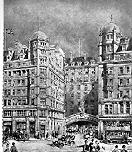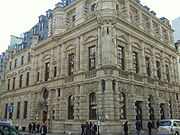
Thomas Edward Collcutt
Encyclopedia

Victorian era
The Victorian era of British history was the period of Queen Victoria's reign from 20 June 1837 until her death on 22 January 1901. It was a long period of peace, prosperity, refined sensibilities and national self-confidence...
who designed several important buildings in London.
Biography
Collcutt was born in OxfordOxford
The city of Oxford is the county town of Oxfordshire, England. The city, made prominent by its medieval university, has a population of just under 165,000, with 153,900 living within the district boundary. It lies about 50 miles north-west of London. The rivers Cherwell and Thames run through...
, England, the son of James Collcutt, a servant at St John's College, and his wife, Emma, née Blake. He attended the Oxford Diocesan School. He was apprenticed to the London architect R. E. Armstrong, and then employed by the partnership Miles and Murgatroyd. He began working in the establishment of George Edmund Street
George Edmund Street
George Edmund Street was an English architect, born at Woodford in Essex.- Life :Street was the third son of Thomas Street, solicitor, by his second wife, Mary Anne Millington. George went to school at Mitcham in about 1830, and later to the Camberwell collegiate school, which he left in 1839...
, with Richard Norman Shaw
Richard Norman Shaw
Richard Norman Shaw RA , was an influential Scottish architect from the 1870s to the 1900s, known for his country houses and for commercial buildings.-Life:...
, before setting up his own practice in 1873 and achieving recognition, winning the Wakefield
Wakefield
Wakefield is the main settlement and administrative centre of the City of Wakefield, a metropolitan district of West Yorkshire, England. Located by the River Calder on the eastern edge of the Pennines, the urban area is and had a population of 76,886 in 2001....
Town Hall competition in 1877, the Grand Prix for Architecture at the Paris International Exposition
Exposition Universelle (1889)
The Exposition Universelle of 1889 was a World's Fair held in Paris, France from 6 May to 31 October 1889.It was held during the year of the 100th anniversary of the storming of the Bastille, an event traditionally considered as the symbol for the beginning of the French Revolution...
in 1889, and the Royal Gold Medal
Royal Gold Medal
The Royal Gold Medal for architecture is awarded annually by the Royal Institute of British Architects on behalf of the British monarch, in recognition of an individual's or group's substantial contribution to international architecture....
in 1902. He was a Fellow of the Royal Institute of British Architects
Royal Institute of British Architects
The Royal Institute of British Architects is a professional body for architects primarily in the United Kingdom, but also internationally.-History:...
, and served as its president from 1906 to 1908. He was a member of the Société Centrale d’Architecture de Belgique, and the Société des Artistes Français.

George Frampton
Sir George James Frampton, RA was a notable British sculptor and leading member of the New Sculpture movement.-Early life and career:...
and a major landmark of the New Sculpture
New Sculpture
The New Sculpture refers to a movement in late 19th-century British sculpture.The term "New Sculpture" was coined by the first historian of the movement, the critic Edmund Gosse, who wrote a four-part series for the Art Journal in 1894...
movement.

Richard D'Oyly Carte
Richard D'Oyly Carte was an English talent agent, theatrical impresario, composer and hotelier during the latter half of the Victorian era...
, Collcutt designed the Savoy Hotel
Savoy Hotel
The Savoy Hotel is a hotel located on the Strand, in the City of Westminster in central London. Built by impresario Richard D'Oyly Carte with profits from his Gilbert and Sullivan operas, the hotel opened on 6 August 1889. It was the first in the Savoy group of hotels and restaurants owned by...
, which has been subsequently altered, and the Palace Theatre, London
Palace Theatre, London
The Palace Theatre is a West End theatre in the City of Westminster in London. It is an imposing red-brick building that dominates the west side of Cambridge Circus and is located near the intersection of Shaftesbury Avenue and Charing Cross Road...
(1889) in Cambridge Circus
Cambridge Circus
Cambridge Circus may be a reference to:* Cambridge Circus , a group of economists who worked with John Maynard Keynes* Cambridge Circus, London, the junction of Shaftesbury Avenue and Charing Cross Road in London...
, Charing Cross Road
Charing Cross Road
Charing Cross Road is a street in central London running immediately north of St Martin-in-the-Fields to St Giles Circus and then becomes Tottenham Court Road...
, which was built as the Royal English Opera House. Sir Arthur Sullivan
Arthur Sullivan
Sir Arthur Seymour Sullivan MVO was an English composer of Irish and Italian ancestry. He is best known for his series of 14 operatic collaborations with the dramatist W. S. Gilbert, including such enduring works as H.M.S. Pinafore, The Pirates of Penzance and The Mikado...
's grand opera
Grand Opera
Grand opera is a genre of 19th-century opera generally in four or five acts, characterised by large-scale casts and orchestras, and lavish and spectacular design and stage effects, normally with plots based on or around dramatic historic events...
, Ivanhoe
Ivanhoe (opera)
Ivanhoe is a romantic opera in three acts based on the novel by Sir Walter Scott, with music by Sir Arthur Sullivan and a libretto by Julian Sturgis. It premiered at the Royal English Opera House on 31 January 1891 for a consecutive run of 155 performances, unheard of for a grand opera...
, was the first production at the theatre. Collcutt also designed the Wigmore Hall
Wigmore Hall
Wigmore Hall is a leading international recital venue that specialises in hosting performances of chamber music and is best known for classical recitals of piano, song and instrumental music. It is located at 36 Wigmore Street, London, UK and was built to provide London with a venue that was both...
(1890). The Palace Theatre and the Wigmore Hall remain essentially in their original forms. Both have strong pale buff terracotta ornamentation, characteristic of Collcutt's work.
Both as president of the RIBA (1906–1908), and later, the causes he promoted included a scheme to move Charing Cross
Charing Cross railway station
Charing Cross railway station, also known as London Charing Cross, is a central London railway terminus in the City of Westminster, England. It is one of 18 stations managed by Network Rail, and trains serving it are operated by Southeastern...
railway terminus to the south bank of the Thames
River Thames
The River Thames flows through southern England. It is the longest river entirely in England and the second longest in the United Kingdom. While it is best known because its lower reaches flow through central London, the river flows alongside several other towns and cities, including Oxford,...
, and another to improve housing conditions for the working classes by replacing slums with towers of flats eight or ten storeys high.
Collcutt died in Southampton
Southampton
Southampton is the largest city in the county of Hampshire on the south coast of England, and is situated south-west of London and north-west of Portsmouth. Southampton is a major port and the closest city to the New Forest...
on 7 October 1924 at the age of 84.

